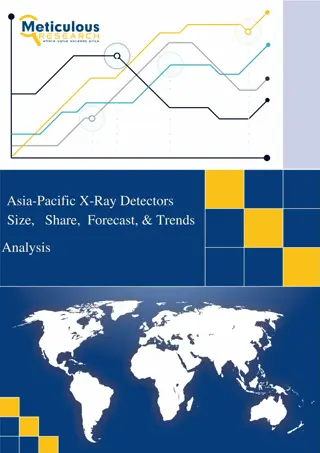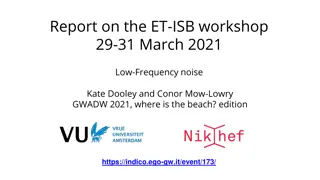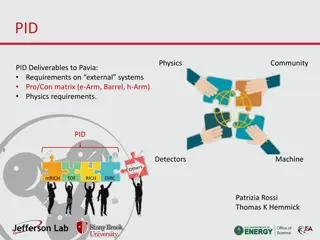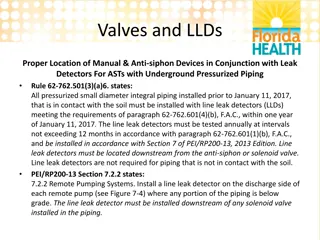Building a FAIR-Compliant Platform for AI-Ready Data in Particle Accelerators
This content discusses the development of a FAIR-compliant platform for AI-ready data in particle accelerators, highlighting the applications of machine learning in various accelerator facilities like CERN, PETRA-III, NSLS-II, HEPS, and more. It emphasizes the importance of high-quality data in acce
2 views • 25 slides
Innovations in Pixel Detector Technology for Photon Science
Technologies and advancements in pixel detector development for photon science applications are showcased in this content. Topics discussed include balancing gain and dynamic range in hybrid pixel detectors, performance assessments of integrating pixel detectors, and strategies for photon detection
4 views • 21 slides
Introducing Turnkey's groundbreaking iPM instrument
\nIntroducing Turnkey's groundbreaking iPM instrument! Revolutionizing air quality analysis, it combines light extinction & scatter for precise airborne particle measurement. Now, track all PM size fractions simultaneously with unmatched accuracy. \nKEY FEATURES:\n1. Measures PM10, PM4 (respirable),
1 views • 2 slides
asia pacific x ray detecter
X-ray detectors are devices or systems used to capture and record X-ray images for medical, industrial, scientific, or security purposes. They are essential tools for visualizing the internal structures of objects and organisms through the use of X-ray radiation. X-ray detectors are used in a variet
1 views • 3 slides
xray detecter
X-ray detectors are devices or systems used to capture and record X-ray images for medical, industrial, scientific, or security purposes. They are essential tools for visualizing the internal structures of objects and organisms through the use of X-ray radiation. X-ray detectors are used in a variet
1 views • 2 slides
Understanding Comminution and Particle Size Reduction in Pharmaceutical Processes
Comminution is the process of reducing particle size from larger to smaller particles, crucial in various industries like pharmaceuticals. This operation involves milling, grinding, and size reduction to make raw materials usable. The particle size plays a significant role in pharmaceutical formulat
2 views • 50 slides
Search for Dark Photons Utilizing Advanced Germanium Detectors at University of South Dakota
Research at the University of South Dakota under the collaboration PIRE-GEMADARC focuses on developing advanced germanium detectors with low energy thresholds for detecting low mass dark photons. The study aims to optimize event detection using new Ge detectors with internal charge amplification. Th
0 views • 16 slides
Insights from ET-ISB Workshop on Low-Frequency Noise and GWADW 2021
The ET Instrument Science Board held a workshop focusing on addressing key challenges related to low-frequency noise in gravitational wave detectors. Experts discussed topics such as mirror temperature, dealing with low-frequency noise realities, and facility limits. The workshop highlighted the sig
0 views • 13 slides
Particle Readout System Overview
This presentation covers the Particle Readout System for events happening on August 18, 2024, detailing the system requirements, detectors involved such as the Time Projection Chamber (TPC) and Forward Tracker (FT), monitoring devices like Beam Position Monitors (BPM), as well as the Forward Tracker
0 views • 30 slides
Advances in Optical Bench Technology for Gravitational Wave Detectors
This content discusses the latest advancements in optical bench technology for gravitational wave detectors, focusing on precise measurements of back-scattered light, development of new optical cavities, and testing of Sagnac interferometers. Key objectives include improving suspension controls, red
0 views • 13 slides
Neutrino Detectors for NuStorm: Physics Goals and Detector Requirements
Physics goals for neutrino detectors in the NuStorm project include measuring exclusive neutrino cross sections, supporting long baseline programs, searching for sterile neutrinos, and improving measurements. Detector requirements involve reconstructing neutrino interactions, providing charge and pa
0 views • 21 slides
Insights into Excess Backgrounds in Dark Matter Searches and Energy Accumulation Effects in Detectors
Explore the impact of excess backgrounds in dark matter searches, energy accumulation, and unsteady releases in detectors. Delve into the implications on low-energy-threshold detectors and the emergence of complex effects in various detector types due to energy accumulation and delayed releases.
3 views • 23 slides
Insights into Gaseous Detectors for Ionization Measurement
Delve into the world of gaseous detectors for ionization measurement, as discussed by Hans-Jürgen Wollersheim. Topics include the Bethe-Bloch formula, ionization detectors, effective ionization energies, charge transport in gas, ion mobility, and electron mobility in gases. Explore concepts such as
2 views • 29 slides
Conducting a Test Beam Experiment - Step-by-Step Guide
In this step-by-step guide, you will learn how to set up and conduct a test beam experiment. The experiment involves connecting detectors such as Cerenkov Detectors, Scintillator Counters, Bubble Chambers, and more. The process includes handling signal cables, high voltage connections, and checking
1 views • 5 slides
WP7-DETEC Kick-Off Meeting: Advancing Detector Technologies for Particle Physics
WP7-DETEC is a collaborative initiative focusing on the development of state-of-the-art detector technologies in the fields of nuclear physics and high-energy physics. The kick-off meeting aims to foster cooperation, exchange ideas, and educate young scientists in the field. Activities include sessi
0 views • 7 slides
Innovative Resistive Layers and Structures for Particle Detection at CERN
Explore the latest advancements in resistive layers and structures designed for particle detection at CERN. The research covers various types of resistive structures, including GEM and BULK Micromegas, and delves into topics such as spark protection, energy levels, and material vaporization. Detaile
0 views • 39 slides
PID Physics Community Deliverables to Pavia: Requirements and Developments
Requirements and developments of external systems and detectors (e-Arm, Barrel, h-Arm) for PID Physics Community to Pavia are detailed. The deliverables include Pro/Con matrices, physics requirements, and advancements in detectors such as mRICH, TOF, RICH, and DIRC. Various simulation results, advan
0 views • 13 slides
Advances in Experimental Particle Physics and Metrology Technologies
This collection of images and text highlights the essential aspects of fundamental physics experiments, particle physics detectors, and the Atlas ITk project. It also focuses on the importance of metrology for physics and satellite experiments, with a specific emphasis on laser technologies. The con
0 views • 11 slides
Enhancing Emittance Control Strategies in Particle Accelerators
The journey to multi-bunch emittance control goes beyond mere feedback mechanisms, involving nuances like pinhole cameras as detectors and skew quadrupole magnets as actuators. This innovative approach aims to overcome limitations of existing systems like coupling control issues and hysteresis perfo
0 views • 16 slides
Analysis Meeting on Cross-talk and Shaping Time in Particle Detectors
This analysis meeting discusses the relation between cross-talk and shaping time in particle detectors. It covers topics such as Ramo-Shockley theorem, weighting field in parallel plate geometry, induction in Micromegas, and signal processing challenges. Understanding the impact of electronics integ
0 views • 8 slides
Understanding EPICS areaDetector Module for Advanced Photon Source at University of Chicago
This content delves into the areaDetector module for EPICS, supporting various detectors used in research settings like synchrotron beamlines. It covers the motivation, goals, architecture, data structures, and detector drivers involved, emphasizing the versatility, efficiency, and support provided
0 views • 35 slides
Experimental Setup at IP5 for Inelastic Events and Particle Detection
Experimental setup at IP5 involves inelastic telescopes for charged particle detection and vertex reconstruction. The setup includes T1 and T2 telescopes, HF and CASTOR detectors, as well as Roman Pots for measuring elastic and diffractive protons. The TOTEM experiment focuses on proton-proton inter
0 views • 27 slides
Introduction to Particle Physics at U. Wisconsin: Physics 535
Dive into the captivating world of particle physics with Physics 535 at University of Wisconsin. Explore phenomena, delve into Quantum Field Theory and Elementary Particle Physics, and prepare for research work. Engage in in-person lectures supplemented by Zoom for those in isolation. Utilize textbo
0 views • 8 slides
Updates on Calorimeter and Cherenkov Detectors in Yerevan Group's SHMS and HMS
Check out the latest updates on the calorimeter and Cherenkov detectors of Yerevan Group's SHMS and HMS. The SHMS detectors are in good shape, while adjustments in HV are needed for the HMS Cherenkov detectors to achieve optimal performance. Images and descriptions are provided in the Elog entries.
0 views • 6 slides
Future Prospects in Dark Matter Research at Fermilab
Exploring new avenues in the realm of dark matter research, Fermilab stands at the forefront with potential upgrades to their detectors, such as the LZ and PICO-X. The presentation delves into the scientific criteria influencing the choice of detectors, the pursuit of understanding dark matter and d
0 views • 6 slides
Understanding Particle Filters in Non-parametric Systems
Particle filters, also known as non-parametric filters, are a powerful tool for state estimation in dynamic systems. These filters represent density using a set of samples drawn from the density, known as particles. Through resampling and reweighting, particle filters track the state of a system ove
0 views • 19 slides
Proper Installation of Valves and Leak Detectors for Pressurized Underground Piping
According to Florida administrative code rule 62-762.501(3)(a)6., all pressurized small diameter integral piping in contact with soil must have line leak detectors installed within one year of January 11, 2017. These detectors should be downstream from the anti-siphon or solenoid valve and tested an
0 views • 4 slides
Exploring Particle Physics at CERN: A Multinational Conference Experience
Participants from various European cities engage in a video conference at CERN, discussing particle physics topics like pronunciation of particle names, technical terms, and multiple-choice questions. Interactions involve learning about the Large Hadron Collider, particle collisions, and particle de
0 views • 25 slides
Exploring Particles and Detectors in Particle Physics Conference
Delve into the world of particle physics with a focus on particle detectors and pronunciation of particle names. Join a diverse group of participants from various countries as they discuss topics like the Large Hadron Collider and particle interactions. Test your pronunciation skills and learn about
0 views • 25 slides
Performance Studies of dRICH Detector at ePIC Experiment
The Electron-Ion Collider ePIC experiment focuses on the performance studies of the dRICH detector for particle identification crucial in various physics channels. The detector features aerogel optimization, SiPM sensors, and test-beam analyses. Key capabilities include different techniques for part
0 views • 28 slides
Advanced Detector Technologies for Particle Physics Experiments
Overview of advanced detector technologies and focal plane detectors used in particle physics experiments, including topics such as electron scattering, energy recovery, and momentum focusing. Details on design requirements, target specifications, and angular range for precise measurements in partic
0 views • 24 slides
Advancements in RWELL Tracking Detectors for Particle Detection
Conducted by Daojin Hong on behalf of USTC MPG Group, this R&D focuses on RWELL detectors, a promising technology for the SoLID tracker detector. Motivated by GEM requirements, the RWELL detector offers advantages like simplicity, compactness, low mass, and discharge suppression. The use of Diamond-
0 views • 17 slides
Detector Assembly and Cryogenics Requirements for ILD Project
The ILD project involves assembling detectors using pre-assembled pieces on surface and lowering them into the assembly area. The detectors are equipped with various components like muon detectors, solenoids, and calorimeters. Magnetic field measurements are carried out during the assembly process.
0 views • 11 slides
Understanding Gated Mode Systems in Particle Detectors
Delve into the intricate details of Gated Mode systems, focusing on aspects such as theory, sensitivity areas, switcher principles, and readout processes without compromising data integrity. Explore the challenges and strategies involved in implementing Gated Mode technology effectively in DEPFET de
0 views • 26 slides
Advancements in Sapphire Detectors for Radiation Hardness Testing and High-Energy Physics Experiments
Reviewing radiation hardness testing, dose estimates, and measurements at LUXE, this content delves into the use of sapphire detectors in high-energy physics experiments. Highlighting sapphire's material properties, such as high radiation resistance, low cost, and specific characteristics, the text
0 views • 13 slides
Particle Physics Quiz - Test Your Knowledge of the Universe!
Engage in a thrilling particle physics quiz with 7 questions to challenge your knowledge! From understanding mass to energy levels and particle interactions, test your skills and learn fascinating facts. Tick off energy steps for each correct answer as you explore the mysteries of the universe. Expl
0 views • 10 slides
Comparative Study of Different Strip Detectors for Dark Current Results
Explore various strip detectors including old baseline, extra-distance, and guard ring surrounding detectors through images showing pixel current behavior when biased. The study highlights the impact of guard ring presence on lowering pixel current in these detectors.
0 views • 6 slides
Complementary Detectors for High-Luminosity Experiments
The work discusses the need for high luminosity at full acceptance in accelerator experiments, outlining boundary conditions and requirements for detectors. Various images illustrate the integration of experimental equipment in the IR, highlighting the structure and components of central detectors.
0 views • 13 slides
Particle Therapy Market Analysis, Share, Trends, and Overview
Particle Therapy Market expansion is primarily propelled by factors such as the increasing incidence of cancer, heightened adoption of particle therapy in clinical research, continual technological advancements, and the proliferation of particle ther
1 views • 3 slides
Particle Size Analysis in Industrial Pharmacy: Methods and Importance
Particle size analysis is crucial in pharmacy for determining the size range and properties of particles. This lecture covers different methods of particle size analysis, such as microscopy, sieve analysis, sedimentation, and electronic determination, along with the importance of particle size in ph
0 views • 47 slides





































